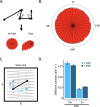Single molecule analysis of CENP-A chromatin by high-speed atomic force microscopy
- PMID: 37728600
- PMCID: PMC10511241
- DOI: 10.7554/eLife.86709
Single molecule analysis of CENP-A chromatin by high-speed atomic force microscopy
Abstract
Chromatin accessibility is modulated in a variety of ways to create open and closed chromatin states, both of which are critical for eukaryotic gene regulation. At the single molecule level, how accessibility is regulated of the chromatin fiber composed of canonical or variant nucleosomes is a fundamental question in the field. Here, we developed a single-molecule tracking method where we could analyze thousands of canonical H3 and centromeric variant nucleosomes imaged by high-speed atomic force microscopy. This approach allowed us to investigate how changes in nucleosome dynamics in vitro inform us about transcriptional potential in vivo. By high-speed atomic force microscopy, we tracked chromatin dynamics in real time and determined the mean square displacement and diffusion constant for the variant centromeric CENP-A nucleosome. Furthermore, we found that an essential kinetochore protein CENP-C reduces the diffusion constant and mobility of centromeric nucleosomes along the chromatin fiber. We subsequently interrogated how CENP-C modulates CENP-A chromatin dynamics in vivo. Overexpressing CENP-C resulted in reduced centromeric transcription and impaired loading of new CENP-A molecules. From these data, we speculate that factors altering nucleosome mobility in vitro, also correspondingly alter transcription in vivo. Subsequently, we propose a model in which variant nucleosomes encode their own diffusion kinetics and mobility, and where binding partners can suppress or enhance nucleosome mobility.
Keywords: chromatin; chromosomes; epigenetics; gene expression; high-speed AFM; human; none; nucleosomes; single-molecule.
Conflict of interest statement
DM, KN, RB, TR No competing interests declared, YD Reviewing editor, eLife
Figures



























Update of
- doi: 10.1101/2022.01.04.474986
Similar articles
-
Cryo-EM Structures of Centromeric Tri-nucleosomes Containing a Central CENP-A Nucleosome.Structure. 2020 Jan 7;28(1):44-53.e4. doi: 10.1016/j.str.2019.10.016. Epub 2019 Nov 8. Structure. 2020. PMID: 31711756
-
High-throughput AFM analysis reveals unwrapping pathways of H3 and CENP-A nucleosomes.Nanoscale. 2021 Mar 18;13(10):5435-5447. doi: 10.1039/d0nr08564b. Nanoscale. 2021. PMID: 33683227
-
The CENP-A nucleosome: where and when it happens during the inner kinetochore's assembly.Trends Biochem Sci. 2023 Oct;48(10):849-859. doi: 10.1016/j.tibs.2023.07.010. Epub 2023 Aug 16. Trends Biochem Sci. 2023. PMID: 37596196 Review.
-
Direct observation of coordinated assembly of individual native centromeric nucleosomes.EMBO J. 2023 Sep 4;42(17):e114534. doi: 10.15252/embj.2023114534. Epub 2023 Jul 20. EMBO J. 2023. PMID: 37469281 Free PMC article.
-
Structure of the CENP-A nucleosome and its implications for centromeric chromatin architecture.Genes Genet Syst. 2011;86(6):357-64. doi: 10.1266/ggs.86.357. Genes Genet Syst. 2011. PMID: 22451475 Review.
Cited by
-
High-resolution analysis of human centromeric chromatin.Life Sci Alliance. 2025 Jan 23;8(4):e202402819. doi: 10.26508/lsa.202402819. Print 2025 Apr. Life Sci Alliance. 2025. PMID: 39848706 Free PMC article.
-
Single-Molecule Studies with AFM and High-Speed AFM: From Nucleosomes to Chromosomes.Methods Mol Biol. 2025;2968:485-508. doi: 10.1007/978-1-0716-4750-9_29. Methods Mol Biol. 2025. PMID: 40884663
-
Vertebrate centromere architecture: from chromatin threads to functional structures.Chromosoma. 2024 Jul;133(3):169-181. doi: 10.1007/s00412-024-00823-z. Epub 2024 Jun 10. Chromosoma. 2024. PMID: 38856923 Free PMC article. Review.
-
Nanoscale Characterization of Interaction of Nucleosomes with H1 Linker Histone.Int J Mol Sci. 2024 Dec 31;26(1):303. doi: 10.3390/ijms26010303. Int J Mol Sci. 2024. PMID: 39796159 Free PMC article.
-
Real-Time Multistep Asymmetrical Disassembly of Nucleosomes and Chromatosomes Visualized by High-Speed Atomic Force Microscopy.ACS Cent Sci. 2023 Dec 22;10(1):122-137. doi: 10.1021/acscentsci.3c00735. eCollection 2024 Jan 24. ACS Cent Sci. 2023. PMID: 38292612 Free PMC article.
References
Publication types
MeSH terms
Substances
Grants and funding
LinkOut - more resources
Full Text Sources
Miscellaneous

